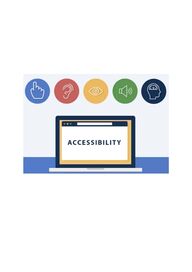
Return to flip book view
Message
October is dyslexia awareness month... The information below is compiled from the British Dyslexia Association and the International Dyslexia Association. As with many areas of neurodiversity we all may experience some of the signs as part of every day life but to experience a number of them and in greater depth can mean additional coping strategies are needed. What is dyslexia? What can we do to be a dyslexia friendly workplace?
There are legal requirements but some thought, and small changes can make a big diƯerence: Awareness of dyslexia and the challenges it presents A flexible and supportive approach Considering whether assistive technology is feasible Consider appropriate communication methods; printing on diƯerent coloured paper, use a larger font or use audio or video formats Things that might help someone working with dyslexia: Let co-workers know you have dyslexia If you have identified adjustments that help you, discuss them with co-workers to check that those adjustments don’t negatively aƯect others Adjust your computer settings Consider whether any learning or courses would help Work your words - became additionally familiar with words that you will use regularly Plan for extra time Use more charts or diagrams if feasible Stay organised
Lunch and learn on Neurodiversity with a focus on ADHD If you were unable to attend, the presentation by Jess Jarvis was recorded and is available: https://www.youtube.com/watch?v=OCfr02UFf1I The snakes and ladders game is available: https://view.genially.com/6672a75fc7ba4400150ca5ed/interactive-content-snakes-and-ladders-adhd The slides and a few PDF infographics are attached. If you have any feedback or comments please let one of the Accessibility team know. Many thanks
Deaf Awareness Week. Edie and Suzie will be in the breakout on Thursday lunch time with more information and some basic finger spelling and sign language for you to discuss and try. Edie is currently at level 4 of her British Sign Language qualifications. An invite will go into your calendar as a reminder that it is happening but the session is purely drop in as and when is convenient. Did you know? 1. It is estimated that there are about 12 million people in the UK who are Deaf or hard of hearing 2. Around 12 thousand people in the UK wear cochlear implants 3. Deafness can be from birth or people can become Deaf 4. Technology is making a huge diƯerence to Deaf people 5. Deafness is the third most common disability in the world but you probably wouldn’t spot a Deaf person in a crowd 6. Most Deaf people don’t view their Deafness as a disability or as a problem that should be fixed. For many of them, it’s a natural part of a cultural experience that they share with friends, both Deaf and hearing 7. Most Deaf people who use sign language use British Sign Language, or BSL. It’s a rich combination of hand gestures, facial expressions and body language 8. BSL isn’t simply English with hand signs, it is a diƯerent language with its own grammar and sentence construction. While you would say “what is your name?” in English, a BSL user would sign, “your name, what?” 9. You might assume that sign language across the world is the same – but actually British Sign Language is totally diƯerent to other sign languages such as American Sign Language or Japanese Sign Language 10. Even the best lip-readers only catch less than half of the words said to them, natural facial expressions and hand gestures can really help 11. 9 in every ten Deaf children are born to hearing parents, but only 1 in 10 of those parents will learn sign language to be able to communicate fully with their son or daughter 12. Deaf people embrace their Deafness and are proud of their history. There is a very strong sense of community and culture amongst Deaf people 13. As a Deaf person you rely on your eyes for clues to what people are saying or feeling, and you rely on other clues like vibrations in floors to be aware of what is going on around you